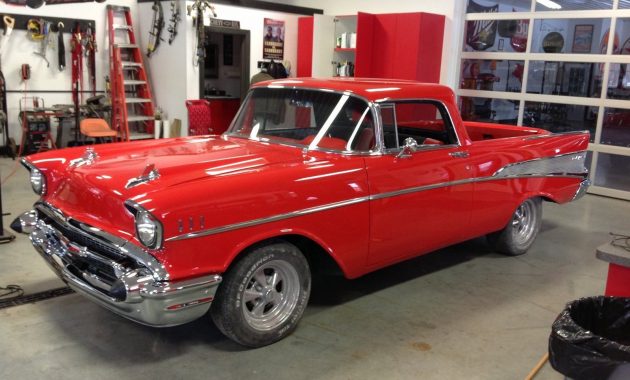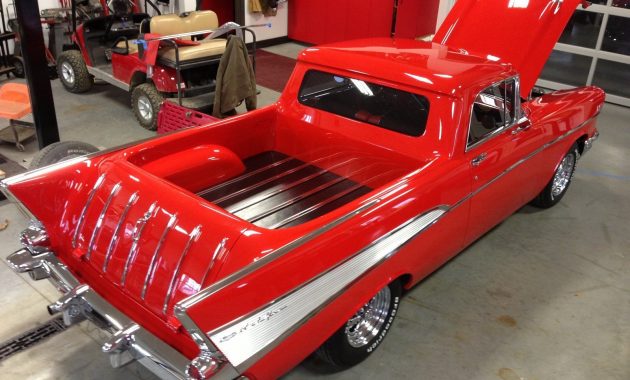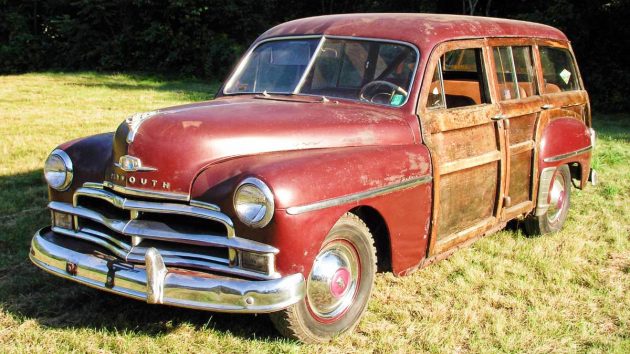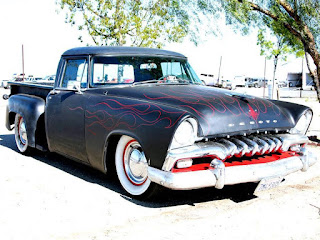Image courtesy Chrysler.
Historically
significant cars resurface all the time—found in barns, fields,
subterranean caverns, even behind brick walls—quite often making news
when they do. After all, their continued existence either confirms or
denies decades’ worth of speculation about their continued existence and
fills in those gaps in the historical record, of which there are
plenty.
It’s for that reason that we automotive journalists tend
to hedge our language when discussing cars that haven’t been seen for
awhile. They’re often described as “missing,” “lost,” or “vanished,”
vague words that simply mean we don’t have a royal clue as to their
whereabouts, oftentimes because they’ve been squirreled away, because
insufficient documentation of their fates exist, or because intrepid car
hunters just haven’t turned over the right rock yet.
That
vagueness can, in turn, lead to serious issues. How many times has a
significant missing car suddenly turned up with a fuzzy provenance that
the incomplete historical record can neither confirm nor deny? Disputes
about the true identities of previously lost cars routinely turn into
high-profile lawsuits and embarrassing situations for less-than-careful
collectors.
Some cars, however, without a doubt no longer exist,
returned to their constituent elements, far beyond restoration or
resurrection. The historical record is unequivocal on their fates. So,
let’s run down some of the most significant cars documented to have
departed us.
 Image courtesy Chrysler.
Image courtesy Chrysler.
We’ll
start with perhaps the most well-documented of them, the Chrysler
Norseman. Designed in Virgil Exner’s studio and built by Ghia in 1956,
the show car featured a Hemi and an A-pillarless cantilevered roof. Ghia
loaded the crated car on the
Andrea Doria to ship it to Chrysler, but in July of that year, the
Andrea Doria sank after a collision with another ship, as detailed by David LaChance in the August 2009 issue of
Hemmings Classic Car.
While other artifacts from the shipwreck have since been retrieved, the
Norseman remains at the bottom of the Atlantic and will never again see
daylight.
According to David Bright, a diver who visited the
Andrea Doria and the Norseman sometime before the mid-1990s,
The
crate had disintegrated and the car was in very, very poor condition.
The ocean’s salt water invaded the Norseman’s metal and most of the car
is rust, corrosion and a heap of indistinguishable junk. The tires are
still there and have assisted to [sic] its identification.
I have
been back to the cargo area several times (it is pretty scary in the
cargo hold because the ship is lying on its starboard side) and visited
the Norseman on a couple other occasions…. I have not been back to this
cargo site since 1994 and with all the decay that the wreck has had over
the past 10 years, it is doubtful if I will (or anyone else) ever get a
chance to see the remains of the Norseman again.
One
footnote of import to the story of the Norseman: Several other
cars—sources say eight—also accompanied the Norseman on that last voyage
of the
Andrea Doria. Rumors abound as to their identities, but
to date no automotive historian has produced a manifest identifying
those other cars.
 Photo courtesy Bob Lichty.
Photo courtesy Bob Lichty.
Speaking
of significant sunken vehicles, let’s take a moment to mention the
one-of-a-kind gas-electric hybrid Snow Cruiser built by the Armour
Institute for Technology for Admiral Richard Byrd’s third Antarctic
expedition in 1939. As Bob Lichty wrote in the June 1985 issue of
Special Interest Autos, the Snow Cruiser—nicknamed “Big Bertha”—made it to Antarctica with the expedition and remained behind when the expedition wrapped up.
Unfortunately,
it remained behind in an ice garage on the East Ross Ice Shelf,
specifically on a section of ice that broke away from the ice shelf in
about late 1961. According to a survey published in the
Journal of Polar Geography in 2005—based on maps, satellite photos, and aerial photos—those calvings from the ice shelf tend to break up in the Bay of Whales and thus “a number of artifacts from the bases, such as the 1939–1941 Snow Cruiser, are likely strewn along the seabed.”
There’s
a slim chance the ice garage remained on the ice shelf and didn’t float
away to sea in 1961, which would make the Snow Cruiser the ultimate
garage find. Good luck getting it back to civilization, though.
 A twin Renault Type CB Coupe de Ville. Photo courtesy RM Auctions.
A twin Renault Type CB Coupe de Ville. Photo courtesy RM Auctions.
One more drowned car, this one from the most famous shipwreck of them all. Reportedly the only automobile to go down with the
Titanic
in 1912 was a new Renault Type CB Coupe de Ville, and we know quite a
bit about it, thanks to the $5,000 insurance claim that owner William
Carter of Bryn Mawr, Pennsylvania, filed with Lloyd’s of London after
the shipwreck. We even know more or less where the Renault currently
resides—in a cargo hold in the forward section of the ship—though,
apparently, in all the trips to the
Titanic nobody has entered that hold to document the current condition of the car.
 Photo courtesy Ford archives.
Photo courtesy Ford archives.
From watery graves to fiery ends. Ford’s Rotunda,
originally built for the Chicago World’s Fair in 1934, later relocated
to Dearborn and became one of the country’s biggest tourist attractions.
That is, until the November 1962 fire that destroyed the building and
nearly everything inside (Ford’s archives escaped destruction, thanks to
a fire-suppression system).
While a number of production models
were on display in the Rotunda at the time of the fire, at least a
couple concept cars were inside as well. The Ford Gyron,
designed in part by Alex Tremulis and Syd Mead, used gyroscopes to
remain stable on its two wheels, while the Levacar Mach 1 dispensed with
wheels altogether to ride on a cushion of air. Both went up in flames
with the Rotunda.
 Photo courtesy USC Libraries.
Photo courtesy USC Libraries.
A
much more devastating fire took place in March 1929 when the entire Los
Angeles Auto Show—then held in a series of large tents—went up in flames,
causing as much as $1.25 million (in 1929 dollars) in damage. The 320
cars that the fire destroyed likely made up the vast majority of that
figure.
Of those 320 cars, perhaps the most significant was the
Auburn Cabin Speedster, a one-off boattail two-door coupe that had
already toured the East Coast auto shows and, according to The Old Motor,
caused a sensation wherever it went due to its extreme styling. While
other carmakers likely displayed what passed for prototypes at the time,
the aviation-themed Cabin Speedster was a true show car built long
before the Buick Y-Job and other concept cars. Whatever was left of the
Cabin Speedster likely got towed to a nearby scrapyard and was written
off. A replica of it has since been built.
 Photo courtesy GM.
Photo courtesy GM.
While
we’re on the topic of concept cars, we can’t ignore the various
Motorama and XP-numbered cars that GM scrapped over the years. Or, at
least, was supposed to scrap. We know that some of those cars avoided
their dates with the crusher, thanks to sympathetic junkyard owners,
and others slipped out the GM styling studio’s back doors, making GM’s
records on the Motorama concept cars—if they were ever to
surface—suspect at best.
So, while thorough research has turned
up a number of Motorama cars as “presumed scrapped”—among them the 1954
Chevrolet Corvette Nomad, the 1955 Buick Wildcat III, the 1955 Pontiac
Strato-Star, and the 1958/1959 Oldsmobile F-88 Mk III—one of the few
Motorama vehicles we can say with relative certainty no longer exists is
the 1955 GMC L’Universelle, an unusual front-wheel-drive cargo van.
Despite extensive tooling and engineering to create the XP-39
L’Universelle’s jackknife doors and behind-the-driver transverse Pontiac
V-8 powertrain,
SIA writers Dave Newell and Robert L. Hauser and Motorama researcher David Temple have listed the L’Universelle as scrapped.
 Photo courtesy Chrysler.
Photo courtesy Chrysler.
True,
a number of Chrysler Turbine cars still exist. Of the 50-car fleet sent
around the country to gauge customer reactions to a turbine-powered car
and the five prototypes that Chrysler built, nine remain in the hands
of museums and collectors, according to Turbine car researcher Steve Lehto.
Exactly why the 46 cars were scrapped has become a topic of controversy, but we can at least prove they were scrapped—there’s video of the cars going into the crusher.
 Photos courtesy Tucker Automobile Club of America.
Photos courtesy Tucker Automobile Club of America.
Finally,
much like the Turbine cars, there’re only so many Tuckers to track
down, and Tucker enthusiasts can tell you where they all have ended up
and exactly how many haven’t survived the decades. Of course, it isn’t
quite fair to label Tuckers 1018, 1023, 1027, and 1042
as completely destroyed, given that parts from each of those cars have
since been used to restore other Tuckers or to help create new Tuckers
from whole cloth.
By all means, this is far from an exhaustive
list—after all, even the most notable cars are subject to rust, neglect,
crashes, and other acts of destruction—so we’d like to hear of other
significant cars you know for sure are no longer around. Share your
additions to this list (along with convincing documentation to support)
in the comments below.
Source: hemmings.com/blog



















































